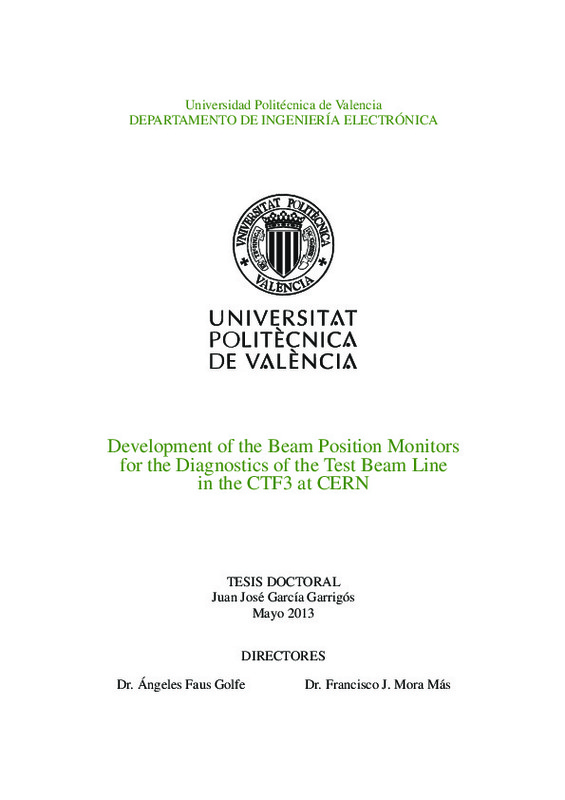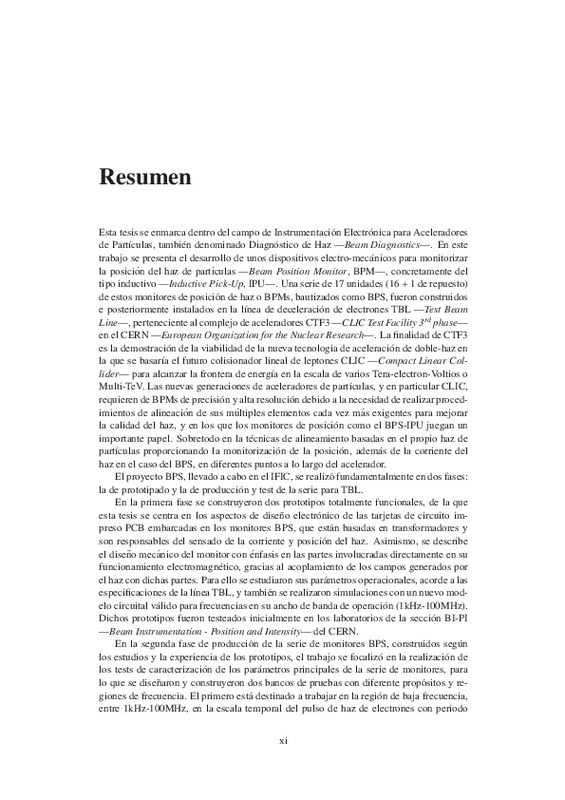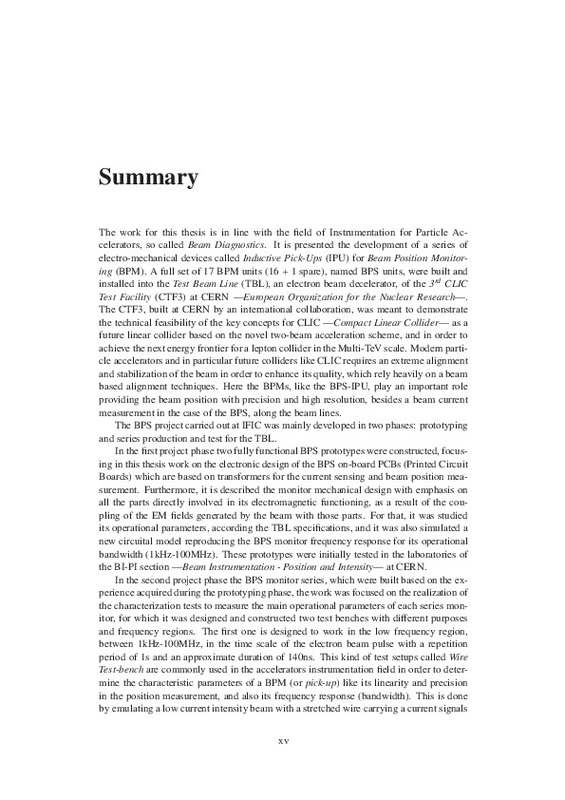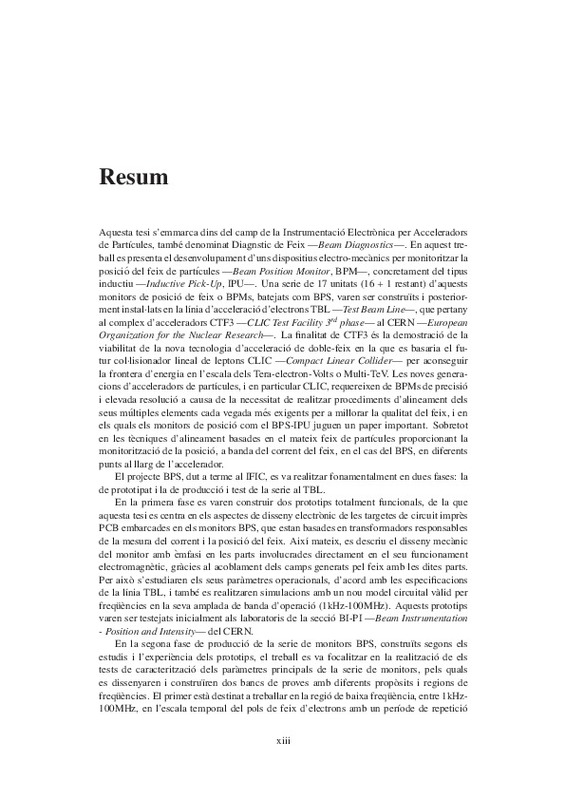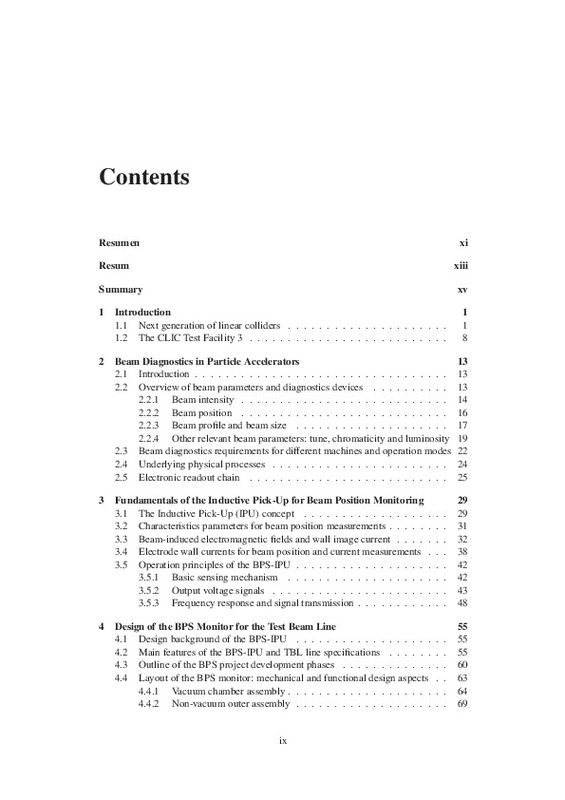- RiuNet repositorio UPV
- :
- Investigación
- :
- Tesis doctorales
- :
- Ver ítem
JavaScript is disabled for your browser. Some features of this site may not work without it.
Buscar en RiuNet
Listar
Mi cuenta
Estadísticas
Ayuda RiuNet
Admin. UPV
Development of the Beam Position Monitors for the Diagnostics of the Test Beam Line in the CTF3 at CERN
Mostrar el registro sencillo del ítem
Ficheros en el ítem
| dc.contributor.advisor | Faus Golfe, Ángeles
|
es_ES |
| dc.contributor.advisor | Mora Mas, Francisco José
|
es_ES |
| dc.contributor.author | García Garrigós, Juan José
|
es_ES |
| dc.date.accessioned | 2013-12-05T11:56:00Z | |
| dc.date.available | 2013-12-05T11:56:00Z | |
| dc.date.created | 2013-11-18T11:00:59Z | es_ES |
| dc.date.issued | 2013-12-05T11:55:57Z | es_ES |
| dc.identifier.uri | http://hdl.handle.net/10251/34327 | |
| dc.description.abstract | The work for this thesis is in line with the field of Instrumentation for Particle Accelerators, so called Beam Diagnostics. It is presented the development of a series of electro-mechanical devices called Inductive Pick-Ups (IPU) for Beam Position Monitoring (BPM). A full set of 17 BPM units (16 + 1 spare), named BPS units, were built and installed into the Test Beam Line (TBL), an electron beam decelerator, of the 3rd CLIC Test Facility (CTF3) at CERN ¿European Organization for the Nuclear Research¿. The CTF3, built at CERN by an international collaboration, was meant to demonstrate the technical feasibility of the key concepts for CLIC ¿Compact Linear Collider¿ as a future linear collider based on the novel two-beam acceleration scheme, and in order to achieve the next energy frontier for a lepton collider in theMulti-TeV scale. Modern particle accelerators and in particular future colliders like CLIC requires an extreme alignment and stabilization of the beam in order to enhance its quality, which rely heavily on a beam based alignment techniques. Here the BPMs, like the BPS-IPU, play an important role providing the beam position with precision and high resolution, besides a beam current measurement in the case of the BPS, along the beam lines. The BPS project carried out at IFIC was mainly developed in two phases: prototyping and series production and test for the TBL. In the first project phase two fully functional BPS prototypes were constructed, focusing in this thesis work on the electronic design of the BPS on-board PCBs (Printed Circuit Boards) which are based on transformers for the current sensing and beam position measurement. Furthermore, it is described the monitor mechanical design with emphasis on all the parts directly involved in its electromagnetic functioning, as a result of the coupling of the EM fields generated by the beam with those parts. For that, it was studied its operational parameters, according the TBL specifications, and it was also simulated a new circuital model reproducing the BPS monitor frequency response for its operational bandwidth (1kHz-100MHz). These prototypes were initially tested in the laboratories of the BI-PI section¿Beam Instrumentation - Position and Intensity¿ at CERN. In the second project phase the BPS monitor series, which were built based on the experience acquired during the prototyping phase, the work was focused on the realization of the characterization tests to measure the main operational parameters of each series monitor, for which it was designed and constructed two test benches with different purposes and frequency regions. The first one is designed to work in the low frequency region, between 1kHz-100MHz, in the time scale of the electron beam pulse with a repetition period of 1s and an approximate duration of 140ns. This kind of test setups called Wire Test-bench are commonly used in the accelerators instrumentation field in order to determine the characteristic parameters of a BPM (or pick-up) like its linearity and precision in the position measurement, and also its frequency response (bandwidth). This is done by emulating a low current intensity beam with a stretched wire carrying a current signals which can be precisely positioned with respect the device under test. This test bench was specifically made for the BPS monitor and conceived to perform the measurement data acquisition in an automated way, managing the measurement equipment and the wire positioning motors controller from a PC workstation. Each one of the BPS monitors series were characterized by using this system at the IFIC labs, and the test results and analysis are presented in this work. On the other hand, the high frequency tests, above the X band in the microwave spectrum and at the time scale of the micro-bunch pulses with a bunching period of 83ps (12GHz) inside a long 140ns pulse, were performed in order to measure the longitudinal impedance of the BPS monitor. This must be low enough in order to minimize the perturbations on the beam produced at crossing the monitor, which affects to its stability during the propagation along the line. For that, it was built the high frequency test bench as a coaxial waveguide structure of 24mm diameter matched at 50¿ and with a bandwidth from 18MHz to 30GHz, which was previously simulated, and having room in the middle to place the BPS as the device under test. This high frequency test bench is able to reproduce the TEM (Transversal Electro-Magnetic) propagative modes corresponding to an ultra-relativistic electron beam of 12GHz bunching frequency, so that the Scattering parameters can be measured to obtain the longitudinal impedance of the BPS in the frequency range of interest. Finally, it is also presented the results of the beam test made in the TBL line, with beam currents from 3.5A to 13A (max. available at the moment of the test). In order to determine the minimum resolution attainable by a BPS monitor in the measurement of the beam position, being the device figure of merit, with a resolution goal of 5¿m at maximum beam current of 28A according to the TBL specifications. | en_EN |
| dc.language | Inglés | es_ES |
| dc.publisher | Universitat Politècnica de València | es_ES |
| dc.rights | Reserva de todos los derechos | es_ES |
| dc.source | Riunet | es_ES |
| dc.subject | Particle Accelerator | es_ES |
| dc.subject | Linear Collider | es_ES |
| dc.subject | Beam Instrumentation | es_ES |
| dc.subject | Beam diagnostics | es_ES |
| dc.subject | Beam Position Monitor | es_ES |
| dc.subject | Inductive pick-up | es_ES |
| dc.subject | CLIC | es_ES |
| dc.subject | CTF3 | es_ES |
| dc.subject | TBL | es_ES |
| dc.subject | CERN | es_ES |
| dc.subject | IFI | es_ES |
| dc.subject.classification | TECNOLOGIA ELECTRONICA | es_ES |
| dc.title | Development of the Beam Position Monitors for the Diagnostics of the Test Beam Line in the CTF3 at CERN | |
| dc.type | Tesis doctoral | es_ES |
| dc.identifier.doi | 10.4995/Thesis/10251/34327 | es_ES |
| dc.rights.accessRights | Abierto | es_ES |
| dc.contributor.affiliation | Universitat Politècnica de València. Departamento de Ingeniería Electrónica - Departament d'Enginyeria Electrònica | es_ES |
| dc.description.bibliographicCitation | García Garrigós, JJ. (2013). Development of the Beam Position Monitors for the Diagnostics of the Test Beam Line in the CTF3 at CERN [Tesis doctoral no publicada]. Universitat Politècnica de València. https://doi.org/10.4995/Thesis/10251/34327 | es_ES |
| dc.description.accrualMethod | TESIS | es_ES |
| dc.type.version | info:eu-repo/semantics/acceptedVersion | es_ES |
| dc.relation.tesis | 7909 | es_ES |
Este ítem aparece en la(s) siguiente(s) colección(ones)
-
Tesis doctorales [5286]






